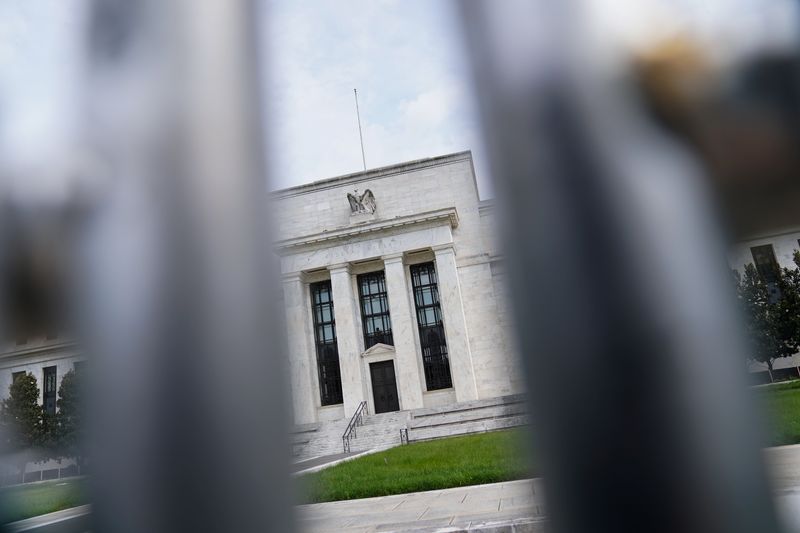By Lindsay (NYSE:LNN) Dunsmuir and Ann Saphir
(Reuters) - The Federal Reserve on Wednesday delivered its third straight 75-basis point interest rate hike in its campaign to drive borrowing costs high enough to bring down 40-year high inflation.
The goal: to get businesses and households to pull back on spending and reduce demand for goods, services and labor, thereby easing upward pressure on prices.
But the process won't be smooth. Regular Americans have felt the sting of inflation for months, and the Fed's effort to lower it so far have already made it harder for many consumers to buy things like a house or a car. Other shoes have yet to drop, though, such as a jump in unemployment or even a recession.
Here's how it could play out:
UNEMPLOYMENT SEEN RISING, INFLATION STILL HIGH
Fed Chair Jerome Powell has said that the rapid and forceful action the central bank is taking will have "unfortunate costs" including a rise in the unemployment rate, currently at a very low 3.7%. Fed policymakers expect it to rise to 4.4% by the end of next year, projections released Wednesday show.
Earlier this month Fed Governor Chris Waller warned the Fed would be comfortable with the unemployment rate increasing to 5% before policymakers start to mull any change in strategy. An increase of that degree - which could translate to more than 2 million jobs lost - has historically been consistent with the economy being in recession. For perspective: in the last three recessions, the jobless rate peaked at roughly 14.7%, 9.5% and 5.5% in 2020, 2009 and 2001, respectively.
None of those recessions, though, were preceded by inflation anywhere near as high as today, a fact that could make a coming downturn more painful.
WAGE GROWTH SLOWS, FEWER JOB OPENINGS
Wages grew at a 5.2% annual rate in August, a strong clip, with the lowest paid workers seeing the biggest rise in their pay packets. But that's where the good news ends. Policymakers view that pace of wage growth as too strong to be consistent with the Fed getting overall inflation back to its 2% goal, so they are trying to tamp it down. The longer those outsized wage gains continue, they worry, the more likely high inflation becomes embedded in the economy in a self-perpetuating spiral.
One reason wage gains have been so strong is fierce demand for a pool of labor that has only just regained its pre-pandemic size, even as the economy has gotten bigger. The availability of nearly two job openings for every job seeker reflects that, and Fed policymakers hope businesses will respond to interest rate hikes mostly by trimming hiring rather than with outright layoffs. Fewer job openings should translate to slower wage growth, meaning that unless inflation comes down quickly more workers will see their pay packets actually shrink after accounting for the hit from inflation.
Fed policymakers see inflation, now at 6.3% by their preferred measure, falling to 2.8% by the end of next year, projections released on Wednesday show.
SAVINGS RATES WILL RISE, BUT SO WILL RATES ON CONSUMER LOANS
Households will see an increase in the interest rate on their savings accounts, particularly at online institutions. But in general, banks are slow to pass on the Fed's rate increases to savers and do so at levels typically far below the central bank's policy rate and, currently, inflation.
Finance companies will also raise their rates on most consumer and auto loans, rates that are generally far above the central bank's benchmark to begin with.
BUYING HOMES LESS AFFORDABLE, BUT RENTS ALSO KEEP RISING
Of all the economy's sectors, the housing market is where the Fed's rate hikes have hit hardest and fastest, with mortgage rates doubling in just over eight months to a current average of 6.25% for a 30-year fixed rate mortgage. Home sales have dropped. But, in part because of a still-acute shortage of homes, prices have only edged down slightly, to $389,500 for the median existing house in August -- still up 7.7% compared with just a year earlier. With the rise in rates, monthly mortgage payments on a median-priced existing home have jumped nearly 60% to $1,940 this year. Roughly 17 million fewer households have the income to qualify for a mortgage for a median-priced home than at the end of last year, economists at Oxford Economics estimate.
Rising rental prices are also squeezing incomes, offering little relief at least over the next few months. The rate of increase based on a weighted average of the two main rent indexes climbed to 6.4% in August from one year ago, while the 3 month annualized rate of increase jumped to 8.6% "suggesting that rents are still in the process of accelerating higher," according to Ryan Wang, U.S. economist at HSBC.
FOOD AND GAS PRICES: NOT MUCH THE FED CAN DO

As much as the Fed raises interest rates to quash inflation, the everyday prices that Americans perhaps care most about -- food and gas - are beyond the central bank's reach, as their cost is determined by global factors largely affecting supply. Gasoline prices, which spiked in the U.S. to more than $5 a gallon in mid June as a result of the fallout from Russia's invasion of Ukraine, have dropped to roughly $3.70 a gallon, the 11th straight week of declines. Wholesale gasoline prices are expected to keep falling in coming months as U.S. refiners overproduce fuel to try to rebuild low stocks of diesel and heating oil, according to analysts and traders.
But the ongoing war in Ukraine as well as severe droughts in Europe and China, will keep U.S. food prices, already up more than 11% compared to one year ago, elevated at least into early next year. Russia's announcement earlier on Wednesday that it will send significantly more troops to Ukraine further escalates the conflict, and could jeopardize a Black Sea corridor established under a U.N.-backed deal that had recently allowed maritime grain exports from Ukraine.